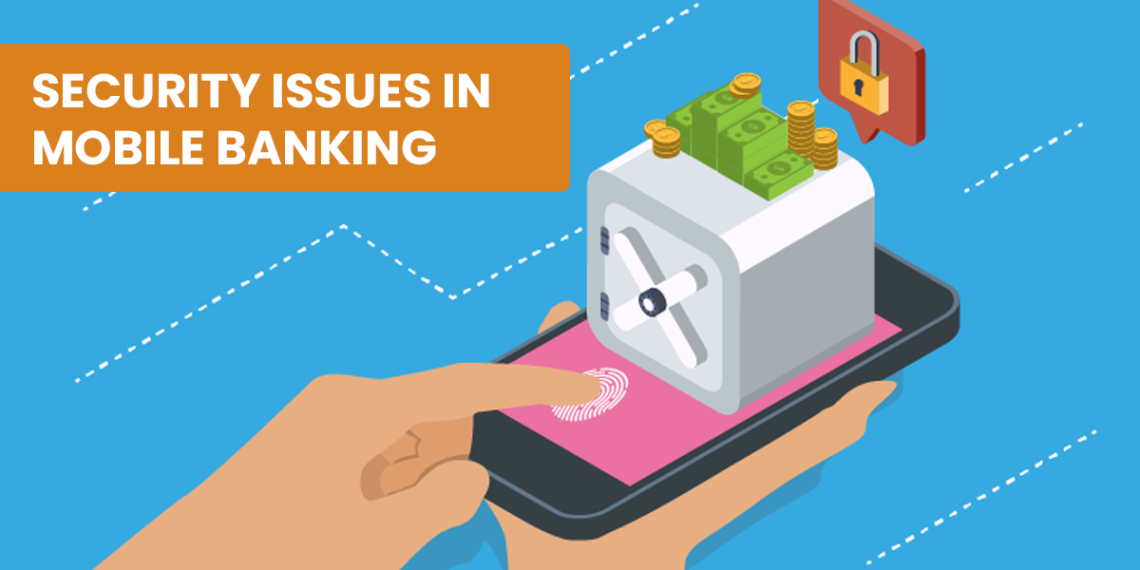Mobile banking is a marvel that has reformed how we manage our finances. Keep reading to deal with security issues in mobile banking. It has become a crucial concern in the modern digital landscape.
With the benefit of banking at our fingertips, it is an integral part of our daily lives. Yet, this comfort comes with its challenges, focused on security.
The adoption of smartphones and mobile applications has reformed how people manage their finances. The benefit offered by mobile banking is certain. However, innate flaws can expose users to threats. It includes identity theft, data breaches, and financial fraud.
Smartphones now integrate sensitive personal data, transactional data, and financial details. Sensitive information on these platforms creates a fertile ground for cybercriminals. Such fraudsters are seeking to exploit flaws in security protocols.
We may see the comfort of mobile banking among financial institutions and users alike. Knowing and addressing specific security issues in mobile banking is essential. It will ensure the integrity and sureness of this evolving financial ecosystem.
This extensive exploration delves into the details of mobile banking security issues. They include mobile banking and examining the threats, flaws, and innovative solutions. Learn security issues in mobile banking and how to fortify the digital platform of financial affairs.
Overview of security concerns in mobile banking
In the fast-evolving cybersecurity view, protecting sensitive financial data is essential. The rise in cyber threats comes with crucial risk and security issues in mobile banking. This makes it an attractive target for attackers. Knowing the enormous setting of security concerns is pivotal for crafting efficient defences.
- Validation and identity theft
- Data encryption and transmission
- Mobile app security
- Device security and malware
- Phishing attacks
- Account management and approval
- Managing compliance
- Importance of protecting financial information
- Rise in cybersecurity threats
- Mobile banking is a target for cybercriminals
Validation and identity theft
Mobile banking apps use username-password combinations, PINs, or biometric validation for access. However, these methods are sensitive to sabotage.
Weak passwords, phishing attacks, and biometric data acquisition contain serious risks. Cyberattackers may exploit these flaws to gain illicit access to a user’s account. Such issues may lead to identity theft and illegal financial affairs.
Data encryption and transmission
Securely shifting sensitive data between the mobile device and the banking server is pivotal. Weak encoding methods in the contact channels can expose user information. Evil actors want to block through the sensitive data.
Sturdy end-to-end encryption is essential to protect users’ personal and financial data. It includes man-in-the-middle attacks during the data transfer.
Mobile app security
The security of the mobile banking application itself is imperative. Attackers exploit the flaws within the app’s code to gain illicit access. They can manipulate transactions or undermine the integrity of the application.
You need to follow regular security audits and code reviews—timely updates to address security issues in mobile banking. Understand and mitigate potential flaws in the mobile banking app.
Device security and malware
The security of the user’s device is an essential factor in mobile banking security. Vicious software, such as mobile malware, can affect the device’s security. It makes you capture sensitive information, including login credentials and transaction details.
Users must employ robust security measures. Install reputable antivirus software to protect the devices from malware threats.
Phishing attacks
Phishing remains a universal threat in the mobile banking landscape. Users may receive fraudulent emails, text messages, or app notices. All these things attempt to trick them into revealing sensitive data.
Educate users about phishing attempts and applying multi-factor confirmation. It can enhance the overall security posture against social deception attacks.
Account management and approval
Deficient account handling practices can lead to prohibited access. Apply strong access controls to prevent control over a user’s account. It includes multi-factor evidence and regular access reviews. It will prevent people from engaging in fraudulent activities.
Managing compliance
Mobile banking institutes must ensure observance of relevant security standards and regulations. Non-compliance may expose both users and financial institutions to legal effects.
Regularly update security protocols to align with industry standards. It will help to meet official requirements. It helps to create a robust security structure for mobile banking services.
Importance of protecting financial information
The essence of mobile security issues and solutions lies in protecting sensitive financial data. Privacy is essential as users rely on mobile devices for banking affairs. The integrity of sensitive information becomes non-negotiable.
Rise in cybersecurity threats
Attackers are becoming more refined in their tactics. They are now exploiting frailties in mobile banking systems. The frequency and intensity of cyber-attacks have intensified over time. Henceforth, it demands a proactive and assertive security approach.
Mobile banking is a target for cybercriminals
The prevalence of mobile banking makes it an attractive target for cybercriminals for financial gain. Understand the motivations and methods employed by these malicious people. It is essential for performing effective cures.

What are the security issues in e-banking?
Meanwhile, the valuing concerns paint a broad picture of such issues. Zooming in on specific security issues related to mobile banking is essential. From illegal access to coding flaws, each issue demands focused attention.
Unauthorised access and licence
Weak passwords
Weak passwords remain a common issue, providing a portal for illicit access. Educating users about the importance of strong, unique passwords is pivotal. It is a basic step in reducing such risks.
Biometric frailties
Biometric proof is more secure than traditional methods. It contains certain challenges. Replication attempts highlight the need for continuous improvement and innovative security.
Two-factor proof challenges
Two-factor proof (2FA) provides an extra layer of security. At the same time, one needs to address specific challenges, such as usage and executing intricacies. Striking a balance between security and user comfort is vital.
Data encryption concerns
Inadequate encryption protocols
The strength of encryption protocols influences data security. Applying robust encryption algorithms is imperative. It will hinder potential spying and data interception attempts.
Data transmission weaknesses
Transmitting data between the user’s device and the banking server is critical. Determining problems in this transmission process is essential. Such measures are pivotal for securing the entire transaction lifecycle.
Risks during wireless contact
Wireless contact introduces an extra layer of frailty. Exploring innovative solutions to secure data transmission over Wi-Fi and mobile networks is essential. It will fortify security issues in mobile banking.
Banking app security
Flaws in app structure
The structure of banking apps plays a pivotal role in determining doubts about cyber threats. Regular security audits and observance of best practices are essential. These will help to identify and rectify security breaches.
Lack of regular security updates
Outdated apps are like open doors for cybercriminals. Keep balance in applying regular security updates. Moreover, developers must adopt active practices to address emerging threats.
Third-party app risks
The risk expands as mobile banking apps incorporate third-party services. Combining efforts between banking institutes and third-party services ensure a united security base.
Device security
Lost or stolen devices
People need to pay more attention to the physical security of mobile devices. Employing remote device management features can help to safeguard data in case of device loss or theft.
Malware and spyware threats
Mobile devices can not resist malware and spyware. Viewing the evolving nature of specific threats and deploying robust antivirus solutions is essential. All these measures are essential to deal with security issues in mobile banking.
Unsecured Wi-Fi networks
Users often connect to public Wi-Fi networks, introducing an element of risk. Educating users about the dangers of unsecured networks can help. In addition, promoting and using virtual private networks (VPNs) can reduce the threat.
Is mobile banking secure?
Mobile banking can be secure, but its security depends on various factors. It may include:

- Applying robust security measures by financial institutions
- Responsible user behaviour
- Continuous adaptation to emerging threats.
Here are key aspects affecting the security of mobile banking:
Security Measures by financial institutions
Financial institutions invest a lot in security issues in mobile banking to protect their relevant platforms. It includes:
- Data encryption in transit
- Secure proof methods (such as biometrics or multi-factor authentication)
- Regular security audits.
Institutions should adhere to industry standards and official requirements. It will create a more secure mobile banking environment.
User practices
The security of mobile banking also depends on the user’s actions. The following practices would be crucial:
- Using strong, unique passwords
- Avoiding public Wi-Fi for sensitive transactions
- Keeping the mobile operating system and banking apps up-to-date.
Users should also be vigilant against phishing attempts. It will refrain from sharing sensitive information through loose channels.
Mobile device security
The security of the user’s mobile device plays an essential role. Applying certain features will contribute to a more secure mobile environment, such as:
- Device lock features
- Installing reputable antivirus software
- Avoid installing apps from unofficial sources.
- Enabling device encryption adds more protection to stored data.
Managing compliance
Adhesion to managing guidelines is essential to maintain the security issues in mobile banking. Financial areas must follow data protection laws and industry-specific regulations. All these measures will safeguard user data and financial transactions.
Continuous monitoring and adaptation
The vital nature of cyber threats requires constant control and adaptation. Financial institutions must stay informed of emerging security threats. They must update their security measures to address new problems. Regular security audits are essential components of a proactive security strategy.
Banking app security issues and measures
Addressing mobile app security issues requires a dynamic approach. Employ robust security measures, from user education to advanced licence techniques. It is crucial for building a solid mobile banking ecosystem.
Importance of user education
Promoting strong password practices
Educating users about the importance of strong passwords is essential. Besides, it provides guidelines to create and manage passwords. It can mitigate the risk of unauthorised access.
Educating users on biometric security
User awareness regarding the limitations and advancements in biometric security is crucial—a clear connection between biometric evidence’s benefits is needed in the long run. The potential risks build trust and informed decision-making.
Encouraging regular app updates
Apply features that prompt users to update their banking apps. It will ensure they benefit from the latest security patches and expansions. Proactive user engagement is vital.
Advanced confirmation techniques
Biometric enhancements
Continual research and biometric technology development are vital to avoid potential issues. Investing in biometric upgrades, such as detectable biometrics, provides extra security.
Multi-factor confirmation advancements
As technology evolves, there will be modern multi-factor confirmation methods. Exploring innovative approaches, such as adaptive proof, enhances security without compromising user experience.
Detectable biometrics
Analysing user behaviour patterns is known as detectable biometrics. They present a promising way to enhance security. This dynamic approach adds a layer of proof, deciding how users interact with their devices.
Robust encryption protocols
Applying robust encryption algorithms
Stay informed of advances in encryption technology and adopting robust algorithms. It ensures that the data in transit remains secure from curious eyes.
Secure data transmission protocols
Adopting secure data transmission protocols would be beneficial in the long run. It assures secure contact between mobile devices and banking servers. Such as:
- Transport Layer Security (TLS)
- Secure Sockets Layer (SSL)
- SSL and TLS best practices (H3)
Educating developers and IT experts on the best practices for applying SSL and TLS would be amazing. It will minimise potential problems arising from absurdity.
Banking app security measures
Regular security audits
Frequent security audits of banking apps help identify application security structure flaws. Internal and external teams usually conduct audits.
Continuous monitoring and updates
Continuous monitoring ensures the detection and address of potential security threats. Real-time updates further strengthen the app against emerging risks.
Joint effort with security experts
Engaging with cybersecurity experts and ethical hackers can provide valuable insights into potential flaws. Hence, united efforts between banks and security experts for a robust defence.
Device security best practices
Remote device management
Enable users to manage and secure their devices remotely. Even if there is any event of loss or theft, security practices will protect sensitive financial data.
Anti-malware and antivirus solutions
Encourage users to install and update reputable anti-malware and antivirus solutions. It will safeguard against malicious software that can breach the security of mobile banking transactions.
Geolocation-based security features
Employing geolocation-based security features can add an extra layer of protection. They will ensure the initiation of banking transactions from authorised locations.

Challenges in ensuring mobile banking security
Security measures continue to advance with every passing day. Challenges persist in achieving a stable balance between security and user ease. To deal with security issues in mobile banking, significant hurdles appear as:
- Balancing security and user ease
- Rapid High-tech advancements and security lags
- Global managing compliance.
Balancing security and user ease
Striking the right balance between robust security measures and user-friendly experiences remains an eternal challenge. The challenge lies in providing a secure environment without affecting the ease and speed.
Rapid High-tech growth and security lag
Technology’s fast-paced evolution introduces new ways for cyber threats. Ensure that security measures keep pace with High-tech growth. It could be a persistent challenge for the mobile banking sector.
Global managing compliance challenges
Navigating the complex landscape of global managing compliance adds an extra layer of difficulty. Banks must ensure their security measures align with diverse managing frameworks. It requires a subtle and adaptable approach.
Mobile security issues and solutions
Mobile security is of collaborative importance between users, app developers, and device operators. Users should adopt secure practices. App developers must prioritise security in their designs, and operators should provide timely updates.
Continuous education and awareness are essential components of maintaining a secure mobile environment.
Malware and mobile viruses
Issue: Mobile devices are susceptible to malware and viruses. It can affect the security and privacy of user data.
Solution: Users should install reputable antivirus software and regularly update their device’s operating system. Avoid downloading apps from unofficial sources. In addition, be cautious with email attachments and links.
Unsecured Wi-Fi networks
Issue: Unsecured public Wi-Fi networks expose mobile devices to potential spying and man-in-the-middle attacks.
Solution: Avoid tricky transactions on public Wi-Fi. Use any virtual private network (VPN) to encrypt internet connections. Such measures will ensure secure data flow.
Inadequate evidence
Issue: Weak passwords or lack of multi-factor evidence can lead to fatal results. It may lead to unauthorised access to mobile devices and applications.
Solution: Use strong, unique passwords and enable biometric or multi-factor evidence. Take all the measures whenever possible to add an extra layer of security.
Phishing attacks
Issue: Phishing attempts via emails, text messages, or fake apps can trick users. Such fraud can get sensitive information from users.
Solution: Educate users on recognizing phishing attempts. It will encourage doubt toward uninvited messages. Employ email and app evidence methods to endorse the accuracy of connections.
Outdated software and apps
Issue: Failure to update mobile operating systems will make devices vulnerable. Other applications lead devices to security exploits.
Solution: Regularly update the device’s operating system and apps to repair security risks. Try to get all the benefits from the latest security features.
Lost or stolen devices
Issue: Physical loss or theft of mobile devices can result in unauthorised access. It may also lead to compromise of sensitive data.
Solution: Allow device locking mechanisms, such as PINs or biometrics. Apply remote tracking and erasing features to secure data in case of loss or theft.
Data leakage
Issue: Apps may request excessive permissions, infecting sensitive information.
Solution: Review and understand app permissions before installation. Only grant necessary permissions and use only privacy-focused apps.
Jailbreaking/rooting
Issue: Jailbreaking (iOS) or rooting (Android) devices can weaken built-in security measures.
Solution: Discourage users from jailbreaking or rooting their devices, as it can expose them to security risks. Highlight the importance of using devices in their default, unchanged state.
Is Mobile Banking Secure? Tips for Safe Banking on Your Phone
Banking on your phone remains secure despite mobile security challenges, offering enhanced safety through best practices and trusted banking apps. However, security concerns persist, necessitating careful measures for secure mobile banking.
To ensure safe mobile banking, follow these essential tips:

Use official banking apps
Ensure you download and use official banking apps from decent sources. You may use the Apple App Store or Google Play Store. Avoid third-party app stores to reduce the risk of downloading vicious applications.
Keep your apps updated
Regularly update your mobile banking apps and your device’s operating system. App updates often include security patches that address flaws and enhance overall security.
Enable multi-factor evidence (MFA)
Whenever possible, enable multi-factor evidence for your mobile banking apps. It will add an extra layer of security by requiring a second form of evidence. For example, a code is sent to your mobile device.
Use strong passwords
Create strong, unique passwords for your mobile banking accounts. Avoid using easily predictable information to avoid security issues in mobile banking. Besides, use a password manager to help you keep track of difficult passwords.
Secure your device
Set up a secure lock screen on your device, such as a PIN, pattern, or biometric evidence. It will add a layer of protection in case the phone is lost or stolen.
Be wary of public Wi-Fi
Avoid conducting sensitive banking transactions on public Wi-Fi networks. These networks may not be secure. If you need to access your accounts, consider using a virtual private network (VPN) to encrypt your connection.
Regularly monitor your accounts
Keep an eye on your bank statements and transaction history. Report any illegal or suspicious activity to your bank immediately.
Educate yourself on phishing
Be careful about phishing attempts through emails, text messages, or phone calls. Legal and valuable banks will never ask for sensitive information via email or text. Verify the validity before providing any information.
Use biometric evidence
Use specific features for added security if your device supports a biometric licence, including fingerprint or face recognition.
Log out after each session
Always log out of your mobile banking app after the completion of transactions. This helps prevent unauthorised access, especially if you share your device with others.
These precautions can resolve security issues in mobile banking. It’s essential to stay informed about the latest security threats and follow any additional references by the bank. By adopting these practices, you can reduce many risks linked with banking on your phone.
Why is mobile banking not working?
Mobile banking is famous as the future of financial transactions. It has met several challenges that have raised concerns about its efficiency. At the same time, the concept promises ease and openness. Certain factors contribute to the perception that mobile banking needs to be fixed with efficacy.
Security concerns
User perceptions and trust issues
One of the primary reasons mobile banking faces distrust is the persistent security issue in mobile banking. Users often need to be more mindful about the safety of their financial data. It may lead to a need for more trust in the security measures of banks and financial institutions.
High-profile data breaches and cyber attacks in the past have left users vulnerable. They question the robustness of mobile banking platforms.
Constantly evolving cyber threats
The dynamic nature of cyber threats poses an ongoing challenge. After applying the security measures, cybercriminals adapt and find new ways to exploit weaknesses.
This real-life chase can make users feel mobile banking is more secure. At the same time, it impacts their willingness to embrace the technology fully.
High-tech limitations
Device harmony and technical issues
Making all mobile devices is not equal. Nonetheless, users may need help with certain banking apps. There could be technical setbacks, app crashes, and slow performance, which can hinder the user experience. It may lead to frustration and security concerns in mobile banking.
Limited features and usage
While mobile banking has become essential, some users find that certain features in traditional banking still need to be improved in mobile applications. There are certain services which may affect the overall user experience, such as:
- Complex transactions
- Detailed financial analysis
- Personalised services
- User experience challenges
- Complexity of onboarding processes
The initial induction process for mobile banking can be complex and time-consuming. Users may need help with setting up their accounts or viewing app functions. Even they face issues while navigating through the various security layers. This complexity can discourage some users from utilising mobile banking.
Customer support limitations
In scenarios where users face issues or have queries, it is crucial for customer support to address concerns. Limited customer support channels or delayed responses can leave users feeling unsupported. Users think mobile banking could be more reliable and start seeking out whether mobile banking is secure.
Compliance issues
Varied managing frameworks
The mobile banking landscape covers diverse managing structures across regions and countries. Navigating such problems poses challenges for financial institutions. Nonetheless, users may perceive differences in conformity standards. It may lead to concerns about the overall sureness and validity of mobile banking.
Data privacy concerns
Rigorous data protection regulations highlight the importance of user privacy. Users may be anxious about the information of their personal and financial data. They get curious when mobile banking applications collect, process, and share. Such data collection contributes to a sense that their privacy is compromised.

Frequently Asked Questions
What is multi-factor authentication (MFA)?
MFA is a security method that requires users to provide two or more confirmation factors. It may include a password and a code sent to their mobile device, enhancing account security.
How can you protect your mobile device from malware?
Install reputable antivirus software, and avoid downloading apps from unofficial sources. In addition, keep your device’s operating system up-to-date to protect against malware.
Why is using public Wi-Fi risky for sensitive transactions?
Public Wi-Fi networks may lack encryption, which makes it easier for attackers to intercept data. Use a virtual private network (VPN) for secure connections.
What is the purpose of a VPN in mobile security?
A VPN encrypts your internet connection, ensuring your data is secure. It will protect you from potential spying, especially on public networks.
Conclusion
In today’s digital age, mobile banking security remains a dynamic challenge, not a one-time task. Implement robust measures by grasping security concerns and tackling them proactively to fortify the sector against evolving threats. Collaborative efforts, user education, and technological innovations are crucial to safeguarding financial transactions. As financial landscapes evolve, staying ahead of potential breaches is paramount.
Mobile banking offers convenience, but users must be vigilant against security threats. Both financial institutions and users play pivotal roles in creating a secure environment. Stay updated with advancing technology to uphold robust security standards.







